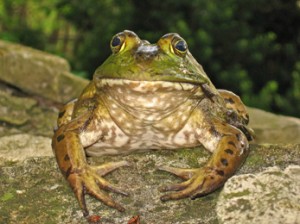Heard, not seen
All about the big ol’ bullfrog
By Scott Stegenga
For The Courier

More likely to be heard than seen, bullfrogs’ eyeballs are raised above their skulls so they can stay almost totally submerged and still be aware of their surroundings.
Anyone who has spent even a little time near the shore of a lake or pond has probably encountered a bullfrog now and then. They are more likely to be heard than seen. In the Upstate, bullfrogs are the largest frog in their family, reaching a length of 6 inches or more. Smaller species in the same family are the leopard, pickerel and green frog.
A bullfrog is perfectly suited for its aquatic habitat. The frog’s color is a plain green or a mottled gray or brown pattern on a greenish background, providing excellent camouflage among vegetation along the water’s edge. Long, strong legs with webbed hind feet enable the bullfrog to be a powerful leaper and swimmer.
The eyeballs are raised above the skull so a bullfrog can remain nearly totally submerged and still see its surroundings. In this position, it can remain hidden from enemies and any prey that comes along. A bullfrog, because of its large size and voracious appetite, will eat almost any creature it can catch and swallow. Small snakes, turtles, mice and even ducklings may become part of the diet of a large bullfrog.
Lakes, ponds, bogs, and quiet sections of streams are the preferred habitat of bullfrogs. They are most common along lakeshores with adequate vegetation and are sometimes seen resting on rocks or debris piles along creeks.
The call of the bullfrog is most often heard in early morning or from dusk into the nighttime hours. Their call is a low, loud moan often described as “jug-o-rum” and can resemble the bellow of cattle, thus the frog’s name is fitting. A large, flat, circular structure located behind each eye is called the tympanum, which serves as the eardrum. In a male, it is larger than the eye, while in the female it is about the size of the eye or smaller.
Bullfrogs breed from spring into the summer. Their large tadpoles can be often seen scurrying away for cover when you approach the edge of a quiet pond. Metamorphosis is usually completed the following year. An adult may be hard to spot, since it sits motionless and wary before suddenly jumping away to dive under the water before you realize it was even there.
Various frog populations have declined over the years due to habitat loss and pollution in wetlands. The skin of a frog is delicate and can easily absorb toxins. Due to that fragile condition and other factors against survival, amphibians are considered indicator species of a healthy environment.
So when you hear that deep call from the water’s edge, or any other frog voices, such sounds bode well for an aquatic ecosystem that has a good balance of life.























